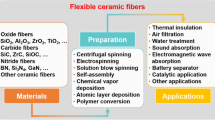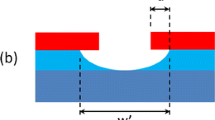Abstract
We have developed a new biofabrication process in which the precise control of bacterial motion is used to fabricate customizable networks of cellulose nanofibrils. This article describes how the motion of Acetobacter xylinum can be controlled by electric fields while the bacteria simultaneously produce nanocellulose, resulting in networks with aligned fibers. Since the electrolysis of water due to the application of electric fields produces the oxygen in the culture media far from the liquid–air boundary, aerobic cellulose production in 3D structures is readily achievable. Five separate sets of experiments were conducted to demonstrate the assembly of nanocellulose by A. xylinum in the presence of electric fields in micro- and macro-environments. This study demonstrates a new concept of bottom up material synthesis by the control of a biological assembly process.







Similar content being viewed by others
References
Archer, S., T. T. Li, A. T. Evans, S. T. Britland, and H. Morgan. Cell reactions to dielectrophoretic manipulation. Biochem. Biophys. Res. Commun. 257:687–698, 1999.
Backdahl, H., G. Helenius, A. Bodin, U. Nannmark, B. R. Johansson, B. Risberg, and P. Gatenholm. Mechanical properties of bacterial cellulose and interactions with smooth muscle cells. Biomaterials 27:2141–2149, 2006.
Barz, D. P. J., and P. Ehrhard. Model and verification of electrokinetic flow and transport in a micro-electrophoresis device. Lab Chip 5:949–958, 2005.
Berg, H. Possibilities and problems of low-frequency weak electromagnetic-fields in cell biology. Bioelectrochem. Bioenerg. 38:153–159, 1995.
Bodin, A., H. Backdahl, H. Fink, L. Gustafsson, B. Risberg, and P. Gatenholm. Influence of cultivation conditions on mechanical and morphological properties of bacterial cellulose tubes. Biotechnol. Bioeng. 97:425–434, 2007.
Bodin, A., S. Concaro, M. Brittberg, and P. Gatenholm. Bacterial cellulose as a potential meniscus implant. J. Tissue Eng. Regen. Med. 1:406–408, 2007.
Borzani, W., and S. J. Desouza. Mechanism of the film thickness increasing during the bacterial production of cellulose on non-agitated liquid-media. Biotechnol. Lett. 17:1271–1272, 1995.
Brown, R. M., C. Haigler, and K. Cooper. Experimental induction of altered non-microfibrillar cellulose. Science 218:1141–1142, 1982.
Brown, R. M., J. H. M. Willison, and C. L. Richardson. Cellulose biosynthesis in Acetobacter xylinum—visualization of site of synthesis and direct measurement of invivo process. Proc. Natl Acad. Sci. USA 73:4565–4569, 1976.
Cellini, L., R. Grande, E. Di Campli, S. Di Bartolomeo, M. Di Giulio, I. Robuffo, O. Trubiani, and M. A. Mariggio. Bacterial response to the exposure of 50 Hz electromagnetic fields. Bioelectromagnetics 29:302–311, 2008.
Czaja, W., D. Romanovicz, and R. M. Brown. Structural investigations of microbial cellulose produced in stationary and agitated culture. Cellulose 11:403–411, 2004.
Davalos, R. V., G. J. McGraw, T. I. Wallow, A. M. Morales, K. L. Krafcik, Y. Fintschenko, E. B. Cummings, and B. A. Simmons. Performance impact of dynamic surface coatings on polymeric insulator-based dielectrophoretic particle separators. Anal. Bioanal. Chem. 390:847–855, 2008.
Dimitrov, D., H. Isoda, and T. Maekawa. Proteomic Analysis of Changes in Excitable and Non-Excitable Cells Exposed to DC Electric Fields of Physiological Strength. Dordrecht: Springer, 2003.
El-Ali, J., P. K. Sorger, and K. F. Jensen. Cells on chips. Nature 442:403–411, 2006. doi:10.1038/nature05063.
Fojt, L., P. Klapetek, L. Strasak, and V. Vetterl. 50 Hz magnetic field effect on the morphology of bacteria. Micron 40:918–922, 2009.
Fuh, C. B. Split-flow thin fractionation. Anal. Chem. 72:266A–271A, 2000.
Fuh, C. B., and S. Y. Chen. Magnetic split-flow thin fractionation of magnetically susceptible particles. J. Chromatogr. A 857:193–204, 1999.
Gascoyne, P. R. C., J. V. Vykoukal, J. A. Schwartz, T. J. Anderson, D. M. Vykoukal, K. W. Current, C. McConaghy, F. F. Becker, and C. Andrews. Dielectrophoresis-based programmable fluidic processors. Lab Chip 4:299–309, 2004.
Giddings, J. C., and S. L. Brantley. Shear field-flow fractionation—theoretical basis of a new, highly selective technique. Sep. Sci. Technol. 19:631–651, 1984.
Helenius, G., H. Backdahl, A. Bodin, U. Nannmark, P. Gatenholm, and B. Risberg. In vivo biocompatibility of bacterial cellulose. J. Biomed. Mater. Res. A 76A:431–438, 2006.
Huang, R., L. Peng, and L. Hertz. Effects of a low-voltage static electric field on energy metabolism in astrocytes. Bioelectromagnetics 18:77–80, 1997.
Ji, W. J., H. M. Huang, A. H. Deng, and C. Y. Pan. Effects of static magnetic fields on Escherichia coli. Micron 40:894–898, 2009.
Kang, Y. J., and D. Q. Li. Electrokinetic motion of particles and cells in microchannels. Microfluid. Nanofluid. 6:431–460, 2009.
Klemm, D., D. Schumann, U. Udhardt, and S. Marsch. Bacterial synthesized cellulose—artificial blood vessels for microsurgery. Prog. Polym. Sci. 26:1561–1603, 2001.
Kolin, A. An electromagnetokinetic phenomenon involving migration of neutral particles. Science 117:134–137, 1953.
Kolin, A., and R. T. Kado. Fractionation of cell suspensions in an electromagnetic force field. Nature 182:510–512, 1958.
Kondo, T., M. Nojiri, Y. Hishikawa, E. Togawa, D. Romanovicz, and R. M. Brown. Biodirected epitaxial nanodeposition of polymers on oriented macromolecular templates. Proc. Natl Acad. Sci. USA 99:14008–14013, 2002.
Krystynowicz, A., W. Czaja, A. Wiktorowska-Jezierska, M. Goncalves-Miskiewicz, M. Turkiewicz, and S. Bielecki. Factors affecting the yield and properties of bacterial cellulose. J. Ind. Microbiol. Biotechnol. 29:189–195, 2002.
Lee, S. W., C. B. Mao, C. E. Flynn, and A. M. Belcher. Ordering of quantum dots using genetically engineered viruses. Science 296:892–895, 2002.
Nalbandian, R. M., R. E. Michel, and I. Mader. Paramagnetism of human serum proteins demonstrated by two-stage electromagnetophoresis. Cell. Mol. Life Sci. 24:1006–1007, 1968.
Pohl, H. A. The motion and precipitation of suspensoids in divergent electric fields. J. Appl. Phys. 22:869–871, 1951. doi:10.1063/1.1700065.
Pohl, H. A., and C. E. Plymale. Continuous separations of suspensions by nonuniform electric fields in liquid dielectrics. J. Electrochem. Soc. 107:390–396, 1960. doi:10.1149/1.2427706.
Putra, A., A. Kakugo, H. Furukawa, J. P. Gong, and Y. Osada. Tubular bacterial cellulose gel with oriented fibrils on the curved surface. Polymer 49:1885–1891, 2008.
Putra, A., A. Kakugo, H. Furukawa, J. P. Gong, Y. Osada, T. Uemura, and M. Yamamoto. Production of bacterial cellulose with well oriented fibril on PDMS substrate. Polym. J. 40:137–142, 2008.
Shafiee, H., J. L. Caldwell, M. B. Sano, and R. V. Davalos. Contactless dielectrophoresis: a new technique for cell manipulation. Biomed. Microdev. 11:997–1006, 2009.
Shafiee, H., M. B. Sano, E. A. Henslee, J. L. Caldwell, and R. V. Davalos. Selective isolation of live/dead cells using contactless dielectrophoresis (cDEP). Lab Chip 10:438–445, 2010.
Simmons, B. A., G. J. McGraw, R. V. Davalos, G. J. Fiechtner, Y. Fintschenko, and E. B. Cummings. The development of polymeric devices as dielectrophoretic separators and concentrators. MRS Bull. 31:120–124, 2006.
Son, H. J., H. G. Kim, K. K. Kim, H. S. Kim, Y. G. Kim, and S. J. Lee. Increased production of bacterial cellulose by Acetobacter sp V6 in synthetic media under shaking culture conditions. Bioresour. Technol. 86:215–219, 2003.
Stevens, M. M., and J. H. George. Exploring and engineering the cell surface interface. Science 310:1135–1138, 2005.
Svensson, A., E. Nicklasson, T. Harrah, B. Panilaitis, D. L. Kaplan, M. Brittberg, and P. Gatenholm. Bacterial cellulose as a potential scaffold for tissue engineering of cartilage. Biomaterials 26:419–431, 2005.
Szot, C. S., C. F. Buchanan, P. Gatenholm, M. N. Rylander, and J. W. Freeman. Investigation of cancer cell behavior on nanofibrous scaffolds. Mater. Sci. Eng. C, 2009. doi:10.1016/j.msec.2009.12.005
Tandon, V., S. K. Bhagavatula, W. C. Nelson, and B. J. Kirby. Zeta potential and electroosmotic mobility in microfluidic devices fabricated from hydrophobic polymers: 1. The origins of charge. Electrophoresis 29:1092–1101, 2008.
Uraki, Y., J. Nemoto, H. Otsuka, Y. Tamai, J. Sugiyama, T. Kishimoto, M. Ubukata, H. Yabu, M. Tanaka, and M. Shimomura. Honeycomb-like architecture produced by living bacteria, Gluconacetobacter xylinus. Carbohyd. Polym. 69:1–6, 2007.
Verschuren, P. G., T. D. Cardona, M. J. R. Nout, K. D. De Gooijer, and J. C. Van den Heuvel. Location and limitation of cellulose production by Acetobacter xylinum established from oxygen profiles. J. Biosci. Bioeng. 89:414–419, 2000.
Vickrey, T. M., and J. A. Garciaramirez. Magnetic field-flow fractionation—theoretical basis. Sep. Sci. Technol. 15:1297–1304, 1980.
Wang, G., X. F. Chen, X. D. Shi, L. J. Yu, B. F. Liu, and G. Yang. Bio-fabrication of patterned cellulose nano-fibers. In: International Conference on Multifunctional Materials and Structures, edited by A. K. T. Lau (Hong Kong, People’s Republic of China, 2008), pp. 1359–1362.
Watanabe, K., M. Tabuchi, Y. Morinaga, and F. Yoshinaga. Structural features and properties of bacterial cellulose produced in agitated culture. Cellulose 5:187–200, 1998.
Wu, L. Q., and G. F. Payne. Biofabrication: using biological materials and biocatalysts to construct nanostructured assemblies. Trends Biotechnol. 22:593–599, 2004.
Yoshinaga, F., N. Tonouchi, and K. Watanabe. Research progress in production of bacterial cellulose by aeration and agitation culture and its application as a new industrial material. Biosci. Biotechnol. Biochem. 61:219–224, 1997.
Zareie, M. H., H. Ma, B. W. Reed, A. K. Y. Jen, and M. Sarikaya. Controlled assembly of conducting monomers for molecular electronics. Nano Lett. 3:139–142, 2003.
Zhou, H., T. X. Fan, T. Han, X. F. Li, J. Ding, D. Zhang, Q. X. Guo, and H. Ogawa. Bacteria-based controlled assembly of metal chalcogenide hollow nanostructures with enhanced light-harvesting and photocatalytic properties. Nanotechnology 20, 2009.
Zimmermann, K. A., J. M. LeBlanc, K. T. Sheets, R. W. Fox, and P. Gatenholm. Biomimetic design of a bacterial cellulose/hydroxyapatite nanocomposite for bone healing applications. Mater. Sci. Eng. C, 2009.
Acknowledgments
We acknowledge the Institute for Critical Technologies and Applied Science (ICTAS) at Virginia Tech for financial support and the NCFL at ICTAS for support with imaging. We thank Dr. Aase Bodin for introducing Mike Sano to the bacterial cellulose field as well as Jaclyn Brennan, Phillip Zellner, Hadi Shafiee for experimental assistance. We also acknowledge Nathan Petersen and Michelle Davalos for assistance with editing.
Author information
Authors and Affiliations
Corresponding author
Additional information
Associate Editor Scott L. Diamond oversaw the review of this article.
Rights and permissions
About this article
Cite this article
Sano, M.B., Rojas, A.D., Gatenholm, P. et al. Electromagnetically Controlled Biological Assembly of Aligned Bacterial Cellulose Nanofibers. Ann Biomed Eng 38, 2475–2484 (2010). https://doi.org/10.1007/s10439-010-9999-0
Received:
Accepted:
Published:
Issue Date:
DOI: https://doi.org/10.1007/s10439-010-9999-0




